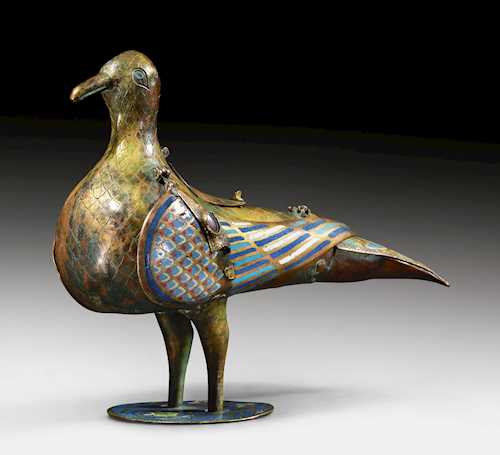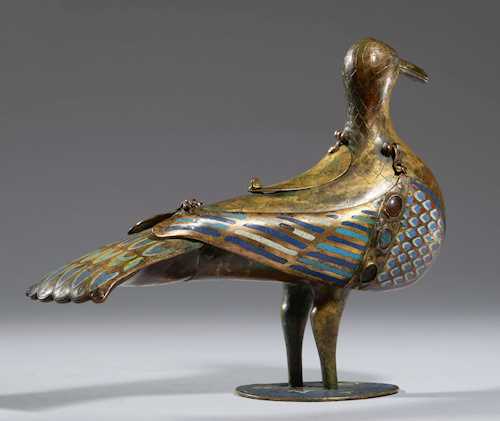
Lot 1017 - A208 Decorative Arts - Thursday, 21. March 2024, 01.30 PM
EXTREMELY RARE EUCHARISTIC DOVE
[Art.ArtText.Text@@1('[Art.BoId],21')]
[Art.ArtText.Text@@1('[Art.BoId],22')]
[Art.ArtText.Text@@1('[Art.BoId],23')]
[Art.ArtText.Text@@1('[Art.BoId],24')]
[Art.ArtText.Text@@1('[Art.BoId],25')]
Provenance: Swiss consignment.
These Limoges doves, referred to in French specialist literature as 'colombe eucharistique', were used in the Eucharistic ceremony to hold the consecrated host. As the 'body of Christ', this represents the Holy of Holies in Christianity. The storage vessel was and is of corresponding importance.
As part of the divine Trinity, the dove symbolizes the Holy Spirit in Christian doctrine. It is regarded as a sign of gentleness and innocence. In most cases, the Eucharistic dove rested on a larger plate, which was suspended by chains in the ciborium that spanned the altar. At that time, it replaced today's tabernacle, which was only introduced at the Council of Trent in 1545-1563.
A comparative classification of the item on offer is attempted here on the basis of the specimens preserved in the world's most famous museums: Rijksmusem in Amsterdam (inv. no. BK-17205), Musée du Louvre in Paris (inv. no. OA 8104), Museum of Fine Arts Boston (inv. no. 49.1075), Metropolitan Museum New York (inv. no. 49.1075), Musée du Cluny Paris (inv. no. CL. 1957).
The base or the plate on which the chains were mounted for suspending the dove has been lost in the case of the dove on offer as well as in the case of several others, such as the examples in the Louvre, the Musée de Cluny and the example in Boston. On the other hand, the dove in the Rijksmuseum stands on a rectangular base with a crenellated edge, while the example in the Metropolitan Museum rests on a round pedestal, the corners of which are elongated upwards and to which the chains were attached.
Basically, the surviving 'colombes' can be divided into two types. These differ mainly in the type of access to the vessel. Some, like the one on offer, are fitted with a hinged lid on the back of the animal (Musée de Cluny, Musée du Louvre, Rijksmuseum, Metropolitan Museum), while others have access from the side under the movable wings (Boston Museum). In the case of those pigeons that provide access via the back, the wings are usually integrated into the vessel or firmly attached to it (Metropolitan, Rijksmuseum, Musée du Louvre).
The piece on offer represents a kind of intermediate solution, which combines the lid on the back with movable wings. It is very close to the specimen in the Musée de Cluny (CL. 1957) in these respects as well as in its overall design. As in the case of the dove on offer, the dove in Cluny has no feet and the hinged wings do not provide access to the vessel, i.e. they have no function. The colors of the enamel on the Cluny version appear to be less vibrant. Overall, however, it is very similar to the one in the Cluny Museum and possibly comes from the same workshop. Cf. an illustration of the colombe in the Musée de Cluny in: Marie-Madeleine S. Gauthier. Emaux Limousins Champlevés des XIIe & XIVe Siècles. Paris 1950. pl. 52.
We would like to thank Richard Camber, former Head of the Byzantine and Early Medieval Art Collection at the British Museum and later Senior Director of the Works of Art Division at Sotheby's, for his assistance in cataloging this object.
CHF 120 000 / 180 000 | (€ 123 710 / 185 570)
Sold for CHF 162 500 (including buyer’s premium)
All information is subject to change.









